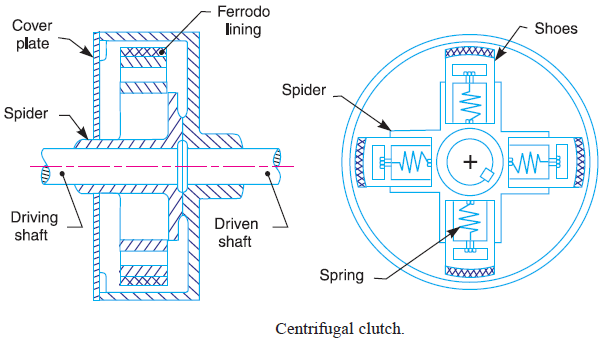Draw the constructional details diagram of centrifugal clutch.
Explain its working principle
Draw the constructional details diagram of Centrifugal clutch. Explain its working principle.
Working Principle of Centrifugal Clutch:
The centrifugal clutch uses centrifugal force, instead of spring force for keeping it in engaged
position. Also, it does not require clutch pedal for operating the clutch. The clutch is operated
automatically depending upon the engine speed. The vehicle can be stopped in gear without
stalling the engine. Similarly the vehicle can be started in any gear by pressing the accelerator
pedal. This makes the driving operation very easy.
OR
The centrifugal clutches are usually incorporated into the motor pulleys. It consists of
a number of shoes on the inside of a rim of the pulley, as shown in Fig. The outer
surface of the shoes is covered with a friction material. These shoes, which can move
radially in guides, are held against the boss (or spider) on the driving shaft by means of
springs. The springs exert a radially inward force which is assumed constant. The mass
of the shoe, when revolving, causes it to exert a radially outward force (i.e. centrifugal
force). The magnitude of this centrifugal force depends upon the speed at which the
shoe is revolving. A little consideration will show that when the centrifugal force is less
than the spring force, the shoe remains in the same position as when the driving shaft
was stationary, but when the centrifugal force is equal to the spring force, the shoe is
just floating. When the centrifugal force exceeds the spring force, the shoe moves
outward and comes into contact with the driven member and presses against it. The
force with which the shoe presses against the driven member is the difference of the
centrifugal force and the spring force. The increase of speed causes the shoe to press
harder and enables more torque to be transmitted.

marks:
- Log in to post comments
